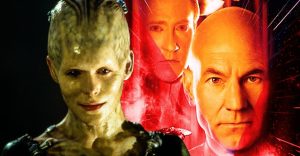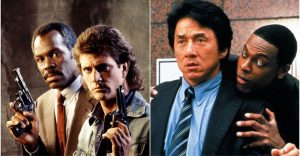Wander Ending Explained

Wander ends on a note of apparent triumph, with the protagonist, Arthur Bretnik, being vindicated in his quest for the truth. A collaboration between director April Mullen and writer Tim Dorton, Wander delves deep into the various conspiracies that lurk beneath the surface of normalcy, along with the visceral paranoia that often accompanies these unsavory revelations. Starring Aaron Eckhart and Tommy Lee Jones, Wander is currently available for streaming on Amazon Prime.
Wander opens with the murder of Zoe Guzman (Elizabeth Selby) at the town limits of the quaint desert hamlet, Wander, in New Mexico. The circumstances around Zoe’s death are baffling, to say the least, as her chest literally explodes once she attempts to flee the confines of the haunting town. What follows is a deep dive into the life of Arthur Bretnik (Eckhart), an ex-homicide detective turned private investigator, who seems to be struggling with inconsolable trauma and inner demons of his own.
Finding solace in the company of conspiracy theorist Jimmy (Jones) and concerned lawyer friend Shelley (Heather Graham), Arthur navigates the blurred lines between nightmares and waking reality with constant vigilance. While hosting a conspiracy podcast together, Arthur and Jimmy stumble upon Zoe’s apparent murder, along with the convoluted mysteries that surround the town of Wander. Here’s the ending of the film, explained and analyzed via the lens of objective truth and subjective experiences that mostly find their roots in loss and trauma.
Is Aaron Eckhart’s Arthur Bretnik A Reliable Narrator?

The trope of the unreliable narrator, when executed well, lends an aura of doubt and inauthenticity to a story that hinges on dizzying mysteries and suspenseful thrill. A masterful example of the same is Akira Kurosawa’s Rashômon, wherein a host of characters proffer conflicting accounts of the same event, highlighting the validity of objective truth in the process. Right off the bat, Wander establishes the unreliable nature of Arthur’s reality, as it is made clear that he suffers from intense trauma-induced paranoia and struggles with mental illness. This is supported by the visible concern harbored by Shelley, who blames Jimmy for twisting Arthur’s perception of the world and often egging him on to plunge into potentially dangerous scenarios. When Arthur receives a distressed on-air call from Zoe’s mother (Deborah Chavez), Jimmy urges him to investigate the town of Wander, which emerges as a nexus of conspiracy of a dark, murkier kind.
However, despite Arthur’s constant anxiety about things that remain hidden, his findings of the disturbing truth behind a possible murder cover-up emerge to be the truth in the end. While this heightened sense of claustrophobia seeps into the very fabric of the film, accentuated by the vibrant cinematography of deserted, desolate spaces, Arthur manages to triumph over the various dead-ends and red herrings whilst raging against the dying of the light, until the very end. One of the greatest strengths of Wander lies in Mullen’s ability to contort fact and fiction, and the contrapuntal existence of possible delusion and tangible evidence that enriches the film’s convoluted narrative as a whole. A host of pertinent questions are raised: Is Arthur simply imagining it all due to his deep-seated trauma of losing his child in a horrific accident, and his wife being in a near-catatonic state? Is the town of Wander simply victim to unsavory accidental deaths, or is it a pit of massive conspiracy concerning human experimentation? While the answers are never clear, nothing is what it seems in Mullen’s Wander.
How Wander Straddles The Line Between Truth and Paranoia

The opening scene of Wander establishes the mysterious circumstances that surround Zoe’s death, who seems to be on the run from something nefarious within the town. This is confirmed by the paramedics and law enforcement officers who arrive at the scene, as they seem to be aware of the unique circumstances that surround the victim’s predicament. Keeping this in mind, Arthur’s hunch that Zoe’s murder is a part of a larger conspiracy does not seem to be far-fetched, especially when considered alongside her mother’s concerned appeals for him to investigate further. Upon arriving in Wander, Arthur is immediately circled by some of the town’s inhabitants, such as Sheriff Luis Santiago (Raymond Cruz), who immediately pulls him over on grounds of suspicion. Despite Arthur’s mounting paranoia, there is some truth to the nefarious occurrences within the town, which is further solidified with the aid of incriminating conversations and hard evidence that he stumbles upon during the course of his investigation.
Also, the presence of Jimmy in Wander further complicates Arthur’s dilemma, as it is later revealed that he was the one who orchestrated the on-air distress call to lure Arthur inside the town’s confines. However, is this revelation simply one of Arthur’s many delusions, or is Jimmy an integral part of a larger conspiracy? During one of the duo’s investigations into an underground human experiment facility, they stumble upon a nefarious government-funded hellhole, involving missing immigrants, chip surveillance, and the complex politics of border control. After Jimmy’s apparent death, Arthur finds himself at the crossroads of crisis again, as it appears that the very fabric of reality is altered and the bodies keep piling up, whilst new players are introduced within the game. Hence, the line between truth and paranoia is maintained at a steady, keeping audiences at the edge of their seats right up till the film’s final frame.
Does Arthur Succeed In Unravelling The Truth Towards The End of Wander?

Despite discovering an underground facility filled with humans in glass cages subjected to various forms of experimentation, Arthur’s reality is put under scrutiny yet again when said facility is deemed non-existent by authorities. The perplexing presence of Elsa (Kathryn Winnick) towards the final half of the film only serves to complicate matters, along with the implication that it was Arthur who had committed various crimes throughout the course of the narrative, as posited by Nick, Shelley’s FBI agent boyfriend. However, as the government is seemingly involved in the persecution of minorities and their systematic abuse, is Nick, and the FBI, also a part of the elaborate cover-up?
As Arthur plays the game of “pawn, patsy, or dead,” he finds himself mortally wounded with the urge to push all boundaries to uncover the truth. In a last-ditch effort to do so, Arthur digs into his chest in search of a chip implant – and finds it. The validity of Arthur’s beliefs is further solidified when Shelley receives posthumous mail sent by Arthur himself, which contains photographs of the countless individuals trapped inside the underground experiment facility in Wander. Despite the improbable and far-fetched nature of Arthur’s theories, they are established as fact in the end, as evidenced by the microchip embedded within his chest, complete with his name and serial number.
What The Ending Really Means

Wander ends with the triumph of a man on a mad quest for truth in a cruel world that hinges upon subdued herd mentality and the guise of normalcy. Justice emerges as the central theme of Wander, as it is gradually revealed that the conspiracies are directly related to Arthur’s past, which invariably led to the death of his daughter. While it is granted that Arthur suffers from a certain dissociation from his immediate reality, as evidenced by his nightmares spilling over into his waking daydreams, his obsessive need to pursue the truth is rewarded by the end of the film. Irrespective of whether is true or believed by society at large, Arthur finds solace in his own truth, finally free of control and surveillance by forces that remain elusive to date. Mortally wounded and on the verge of death, Arthur relishes in the comfort of retribution, laughing at the absurdity of existence and the twisted nature of freedom and control. Finally, in death, Arthur is able to overcome his inner demons and uncover the true nature of things, no matter how fantastical or convoluted.
About The Author


















